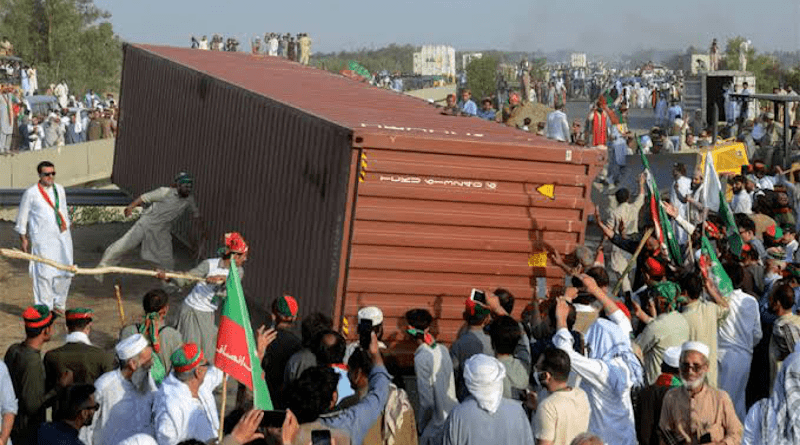Pakistan: Parallels Of Mob Violence Between PTI And TLP Politics – OpEd
“Mob culture” typically refers to a phenomenon where a group of people engages in collective behavior that is characterized by irrationality, emotional intensity and a disregard for individual judgment or responsibility. It often involves a large gathering of individuals who act as a unified group, displaying similar attitudes, beliefs, and behaviors.
The term “mob” in this context does not necessarily refer to organized crime groups but rather to a temporary assembly of people driven by shared emotions and a desire for conformity. The behavior in mob culture can range from peaceful and constructive to destructive and violent, depending on the circumstances, motivations, and external factors influencing the group. In some cases, mob culture can be driven by genuine concerns, such as fighting for social justice or addressing perceived injustices. However, it can also be fueled by misinformation, rumors, or a desire to exert power over others. Overall, mob culture is a complex social phenomenon that highlights the influence of group dynamics on individual behavior, often resulting in actions that individuals might not have taken under different circumstances.
PTI is the first party that introduced the “Dharna” culture in Pakistan in August 2014 by launching its Azadi March towards Islamabad. During this March PTI protestors gave a 126 days sit-in in Islamabad D-chowk. These footsteps of PTI were followed by Tehreek Labaik Pakistan (TLP) in 2017. They gave three weeks of sit-ins in Islamabad against the government of Muslim League-N for making amendments to the Election Bill 2017. In 2018 PTI came into power intending to deliver better than its predecessor party but unfortunately it could not fulfil the promises.
During PTI rule the TLP came into the limelight due to its violent protests and promotion of violent mob culture. TLP has a timeline of violent protests during the PTI rule in which the mass mob turned violent against law enforcement agencies (LEAs) and led to the destruction of public property. In October 2018 TLP held countrywide protests on the acquittal of blasphemy accuser Christian woman Asia Bibi. Which were ended after the PTI government reached 5 points agreement with the TLP. In November 2018 the TLP threatened the government to protest if the PTI government failed to fulfill the October agreement’s points due to which the PTI government take into “protective custody” the leader of the TLP. Then November 2020, January 2021, April 2021, and October 2021 the TLP since its creation held 7 protests all of which were violent in nature in which a mass mob vandalized the government and public property and took hostage the security personnel. The loss of lives was also witnessed in these protests. The TLP through violence brought the government to the negotiation table. The TLP on April 15, 2021, was banned by the Pakistan Tehreek Insaf government due to its violent protests.
Now PTI has chosen the same path that TLP has chosen. On May 9, 2023, PTI leader Imran Khan was arrested from the Islamabad High Court premises by the Paramilitary force of Pakistan Rangers on the arrest warrant issued by the National Accountability Bureau (NAB). This arrest brought a greater level of anger and discomfort in the PTI party leadership. They gave the call for nationwide protests and blamed the Pakistan Army for its alleged involvement in the Imran Khan arrest. They also blamed Pakistan intelligence agency and Army Chief General Asim Munir. Soon after the arrest of Imran Khan nationwide violent protests erupted. People started to attack and destroy public property. They were so infuriated that they even attack the military installation in the whole country and burnt their martyred sculptures. In Rawalpindi, they attacked the General Headquarters of the Pakistan Army (GHQ). These protestors were in the form of violent mob which is guided by illusions. As Gustave Le Bon in his book The Crowd: A Study of the Popular Mind says “The masses have never thirsted after truth… Whoever can supply them with illusions is easily their master; whoever attempts to destroy their illusions is always their victim.”
So, those violent masses were unable to control them at that time. The military restrained itself in the whole scenario to avoid casualties. On the 9th of May night when the situation started to get worse the police intervened to control the mob. But the situation kept getting out of hand. On the 10th of May protestor used light machine guns on the military installations in Peshawar. The mob was out of the hands of law enforcement agencies as they were getting more and more violent to pressurize the state and judiciary to release Imran Khan. The situation settled down after the interim bail of Imran Khan.
The whole scenario of PTI this time violent mob protest was to pressurize the government a tactic one TLP used to do it. They tried so hard that they even broke into Army General’s houses and military installations. The PTI leadership wanted to break the deal with the government by using violent mobs as their new tool. Although government remain steadfast and did what it can do to prevent the catastrophe to which side the PTI violent mob wanted to take the country. PTI leadership and whoever’s the idea of attacking military installations and getting violent should have kept in view the TLP which used the same tactics to pressurize the government was banned by their government.
Sulaiman Mueez is a graduate of Peace Studies from National Defence University, Islamabad, Pakistan. Focus of interest include developmental studies, social movements & structural violence. Also working as a research intern with the Centre of Strategic & Contemporary Research (CS&CR).

